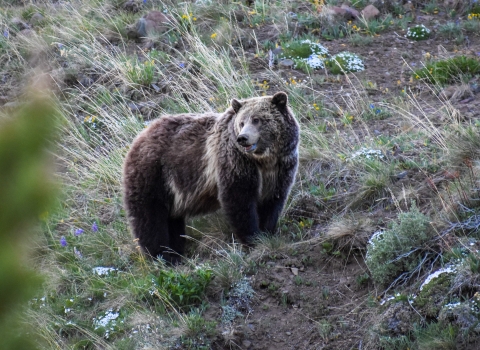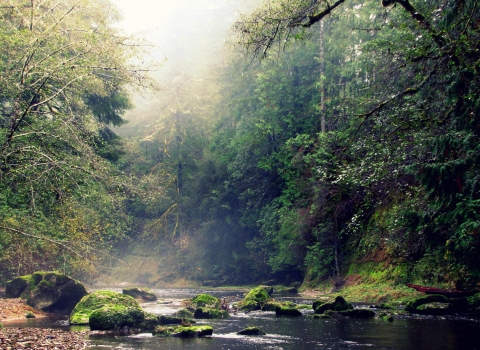The U.S. Fish and Wildlife Service has completed 90-day findings on petitions to list four species under the Endangered Species Act (ESA). Based on our review, we find that the petitions to list the southern population of bog turtle, ghost orchid, Pedernales River Springs salamander and tall western penstemon present substantial information that the petitioned actions may be warranted. The Service will add these species to the National Listing Workplan and initiate status reviews for each species.
The ghost orchid grows in southwestern Florida’s Collier and Hendry counties and in Cuba. It prefers deep swamps, high humidity, mild temperatures and dappled shade. It produces seeds only in the wettest locations. The leafless plant attaches itself by its roots high up on trees, making its white blossoms with trailing petals appear to hover in the air. The photosynthetic roots require a special type of symbiotic fungus to obtain nutrients. Their nighttime scent attracts large moths with proboscises (or mouth parts) long enough to reach pollen deep within the ghost orchid flower. Threats to the species and its habitat include draining of wetlands, large scale land conversion, real estate development, logging and prolonged droughts. Poaching, recreation overuse, competition from invasive species invasive species
An invasive species is any plant or animal that has spread or been introduced into a new area where they are, or could, cause harm to the environment, economy, or human, animal, or plant health. Their unwelcome presence can destroy ecosystems and cost millions of dollars.
Learn more about invasive species , pest insects, sea level rise, and hurricanes were also found to be threats. We find that the petition presents substantial scientific or commercial information that listing the rare, swamp-dwelling ghost orchid as threatened or endangered under the protections of the Endangered Species Act (ESA) may be warranted. We will fully evaluate all potential threats during our 12-month status review, pursuant to the Act’s requirement to review the best scientific and commercial information available when making that finding.
Bog turtles are a wetlands species readily recognized by their yellow-orange cheek spot and their diminutive size – with a shell growing up to 4.5 inches long, they're North America’s smallest turtle. The southern population of bog turtle lives in a variety of rare wetland types collectively called southern Appalachian bogs in Georgia, North and South Carolina, Tennessee, and Virginia. The southern population was listed in 1997 as threatened due to similarity of appearance, a special status offering limited protection under the Endangered Species Act (ESA), to address threats stemming from poaching for an illegal turtle trade, which is a significant threat to the turtle. Additional threats to the species include limited availability and loss of mountain bog habitats due to drainage, conversion to other uses, and degradation due to changes to water flow or plant communities resulting from human impacts on the landscape. We find that the petitions present substantial scientific or commercial information that the southern population of the bog turtle may qualify as a distinct population segment (DPS) which may warrant listing under the ESA. The Service will fully evaluate all potential threats to the species, including DPS considerations regarding significance, during a 12-month status review, pursuant to the Endangered Species Act’s requirement to review the best available scientific information when determining whether or not to list a species.
The tall western penstemon is one of the rarest vascular plants in the Pacific Northwest and lives today in just five known populations, narrowly distributed from southwestern Washington to northwestern Oregon. The species is part of a genus of plants known as “beardtongues.” Its vivid purple-blue flowers, perched high atop its unusually long stems, make the tall western penstemon a distinctive and beautiful presence in the region’s rare, ecologically intact wet prairies. We find that the petition presents substantial scientific or commercial information indicating that listing the tall western penstemon as a threatened or endangered species may be warranted. The Service will fully evaluate all potential threats during our 12-month status review, pursuant to the Endangered Species Act’s requirement to review the best available scientific information when determining whether or not to list a species.
The Pedernales River springs salamander (Eurycea sp.) is a yet-to-be scientifically described member of the central Texas salamander genus Eurycea, which includes several federally listed species that are known only from the Edwards Plateau region. The Edwards, Edwards-Trinity, and Trinity Aquifers and their related springs, spring-fed creeks and water-filled subterranean spaces provide vital habitat for central Texas Eurycea. Individuals move between aquatic surface and subsurface habitats on a seasonal basis and/or in response to dry or wet conditions, making the presence of these salamanders a good indicator of groundwater quality. In 2019, a comprehensive study conducted by researchers at The University of Texas at Austin determined that the Pedernales River springs salamander is a distinct, new species closely related to the endangered Barton Springs salamander. Populations of the Pedernales River springs salamander are known from northeastern Blanco, northwestern Hays and southwestern Travis counties.
The ESA allows citizens to petition the Service to add species to the ESA list, remove species from the list, and to reclassify species already on the list. To the maximum extent possible, the Service issues a finding on a petition within 90 days of the petition’s receipt.
Substantial 90-day findings represent a relatively low bar, requiring only that the petitioner provide information that the petitioned action may be warranted. The next steps involve in-depth status reviews and analyses using the best available science and information to arrive at a 12-month finding. The public can play an important role by sharing relevant information with the Service.
The Federal Register docket numbers and links for the substantial petition findings in this batch are:
Common Name | Range | Docket Number | Docket link onhttps://www.regulations.gov |
Bog Turtle | GA, NC, SC, TN, VA | FWS-R4-ES-2022-0042 | |
Ghost Orchid | FL, Cuba | FWS-R4-ES-2022-0041 | |
Pedernales River springs salamander | TX | FWS-R2-ES-2022-0014 | |
Tall western penstemon | OR, WA | FWS-R1-ES-2022-0071 |
The notice for the above findings will be available in the Federal Register Reading Room on October 18, 2022 at https://www.federalregister.gov/public-inspection on the 2022 Notices link under Endangered and Threatened Wildlife and Plants.
For more information on the ESA listing process, including 90-day findings and status reviews, please go to www.fws.gov/endangered/esa-library/pdf/listing.pdf.



